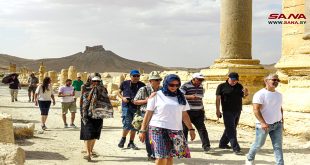Paris, SANA – Director-General of the United Nations Educational, Scientific and Cultural Organization (UNESCO), Irina Bokova called upon the international community and Security Council to do everything in their power to protect the “unique cultural heritage” of Palmyra in central Syria.
The ruins at the ancient city, which are one of the region’s most renowned archeological sites, are threatened by terrorist and extremist groups, that started last week a large-scale assault against the city, a UNESCO world heritage site,
Speaking in a video tape published on UNESCO site, Bokova warned that the destruction of Palmyra would be an “enormous loss to humanity”.
Palmyra is an extraordinary World Heritage site in the desert and any destruction to Palmyra (would be) not just a war crime but … an enormous loss to humanity,” she said.
She urged the international community, including the UN Security Council, to launch an appeal to stop the violence and prevent repeating the terroristst-inflicted destruction in Nimrud city and Mosul Museum in Iraq.
“It is important because we are speaking about the birth of human civilization, we are speaking about something that belongs to the whole of humanity,” Bokova added.
While terrorist groups, mainly the Islamic State in Iraq and Syria (ISIS), which is notorious for demolishing archaeological treasures since its advance on northern Iraq and Syria last year, Western countries have till this moment been standing still doing nothing to protect the city.
The Western countries have neither heeded the UNESCO’s repeated appeals for saving Palmyra, nor have they issued any statements or condemnations of ISIS attack against the city.
They have also refrained from exerting any pressure on the terrorists or the countries which are backing and funding them to stop their attack on Palmyra and the other areas in Syria or elsewhere.
Palmyra, famous for its 2,000-year-old towering Roman-era colonnades, contains the monumental ruins of a great city that was one of the most important cultural centers of the ancient world. From the 1st to the 2nd century, the art and architecture of Palmyra, standing at the crossroads of several civilizations, married Graeco-Roman techniques with local traditions and Persian influences.
The splendor of the ruins of Palmyra, rising out of the Syrian desert north-east of Damascus is testament to the unique aesthetic achievement of a wealthy caravan oasis intermittently under the rule of Rome from the Ist to the 3rd century AD. The grand colonnade constitutes a characteristic example of a type of structure which represents a major artistic development.
Manar al-Frieh/Haifa Said
 Syrian Arab News Agency S A N A
Syrian Arab News Agency S A N A




